There are many factors to consider when deciding on the scale at which to develop a renewable energy project. Cost, access to resources, planning permission requirements and risk are all valid factors to consider.
However, in the case of renewable electricity generators, one of the most important factors to consider is the volume of electricity you can physically export through the grid. This volume is often limited for a range of reasons which, in turn, restrict the potential size of that project.
This is known as “stranded” electricity and can occur on any renewable electricity project including solar PV systems, wind farms and anaerobic digestion (AD) plants.
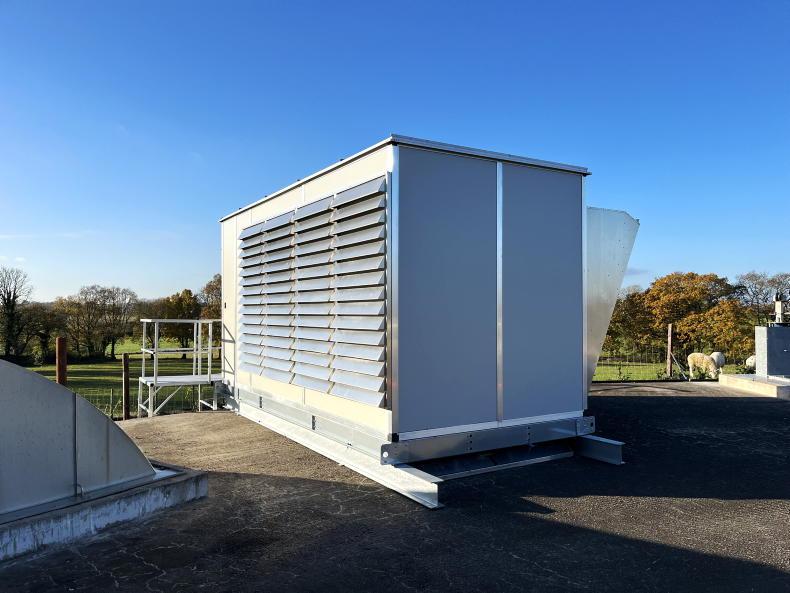
The bitcoin mining unit sits on top of Tom Campbell's AD plan in Lurgan, Armagh
However, one such AD plant in Lurgan, Co Armagh, has partnered with Cork company Scilling Digital Mining to use the stranded electricity from the plant to mine bitcoin. The Irish Farmers Journal recently visited the site to learn more.
AD plant
Tom Campbell runs a 500kW Hochreiter AD plant which produces electricity on his farm outside of Lurgan. The plant uses around 8,000t of feedstock per year, which consists of a combination of grass silage, farmyard manure, whole crop forage and dairy waste to produce biogas. The biogas is burned in a power plant to produce electricity which is then exported through the national grid.
Like most AD plants in Northern Ireland (NI), the project is supported by the NI Renewables Obligation (NIRO), a 20-year government support scheme.
Under the scheme, AD plants with an output of 500kW or below are awarded four Renewable Obligation Certificates (ROCs) per kWh of electricity produced and these can be traded at a premium. However, AD plants above 500kW are only awarded three ROCs so many farm-scale AD plants found it more economically viable to stay just below 500kW in output.
However, like Tom’s operation, many AD plants have the capacity to produce more electricity but, due to the constraints of the scheme, they would not be able to export this to the grid.
Tom thought he could increase output from his AD plant by another 200kW without any significant infrastructural change so he decided to explore alternative ways to use this stranded electricity. He had a keen interest in the emerging digital currency industry where he found Mark Morton of Scilling Digital Mining. Together, they developed the world’s first biogas-powered bitcoin mining system.
Scilling Digital Mining
Mark and his business partner Stewart Hosford founded Scilling Digital Mining in 2021. From a farming background in Cork, Mark studied financial maths and actuarial science in college and always had a keen interest in bitcoin. Having looked at several options to get involved with bitcoin and accumulate as much of it as possible, they decided that developing a system that generated new bitcoin was the best way forward for them.
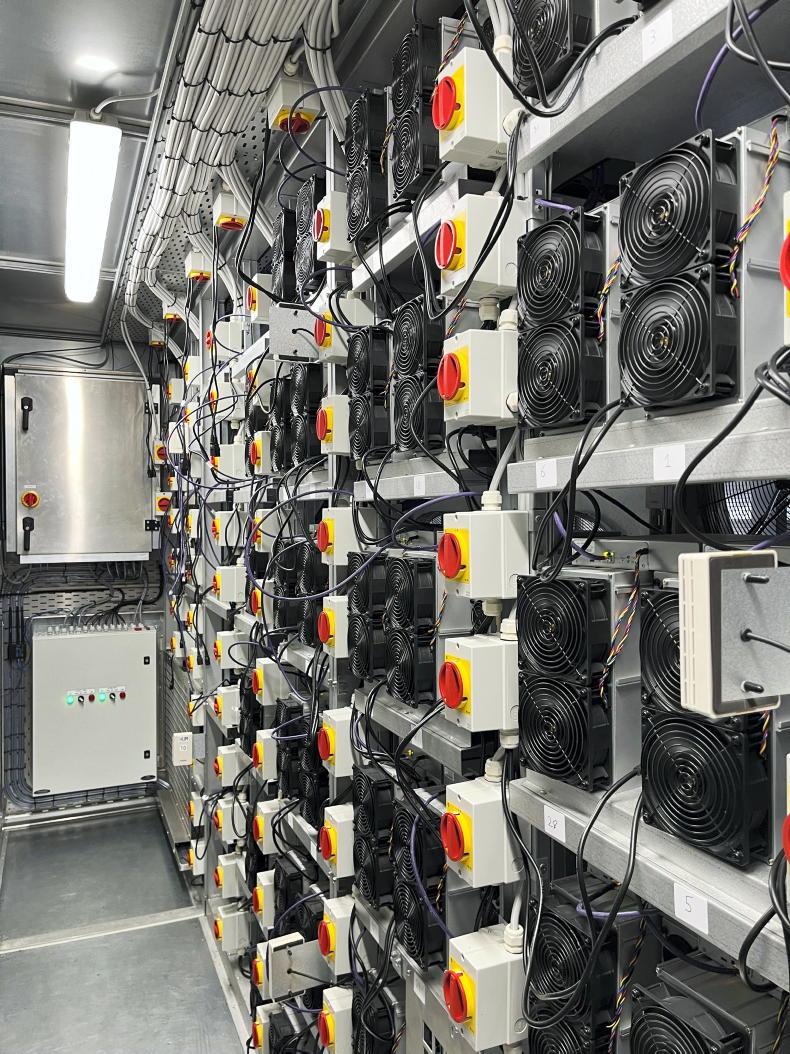
The unit are 35 Application Specific Integrated Circuits (ASICs) which are the specialised machines designed to generate guesses as quickly as possible.
Bitcoin first appeared to many of us around 2015 but it was actually developed in 2009. It’s a digital global payment system or cryptocurrency which can be traded or used as digital tender.
New bitcoins are generated through a system called mining. The process of bitcoin mining involves machines trying to guess a code to verify blocks of digital transactions on the bitcoin blockchain ledger.
The bitcoin blockchain ledger is essentially just like a ledger used in traditional accounting which has time-stamped all the transactions that have occurred since its inception in 2009. Each block contains transactions that have occurred in a 10-minute period.

Tom runs a Hochreiter AD plant which has a concrete roof where the unit sits on top of.
Basically, every block that appears on the bitcoin blockchain has an extremely long combination code that must be guessed correctly before that block can be added to the blockchain. If the machine guesses correctly, then the miner is automatically rewarded in bitcoin by the network. On average a new block is added every 10 minutes. In simple terms the mining process is akin to playing a lottery that occurs every 10 minutes.
Mining bitcoin is energy intensive and Mark explained that it would not be economically feasible to import electricity to run the system and it would also put pressure on the local grid.
That is why they target stranded electricity from renewable generators to power the bitcoin mining system.
Modular system
Mark developed a unique modular unit which contains all of the components needed for using stranded electricity to mine bitcoin. The unit was designed in conjunction with two other Irish companies, Mark Eire and Weldon Electrical. It consists of a corrosion-resistant aluzinc container with intake and extraction fans to moderate internal temperature.
Inside the unit there are 35 application-specific integrated circuits (ASICs), which are the specialised machines designed to generate guesses as quickly as possible. Each ASIC generates 104 trillion guesses per second. The unit can accommodate a further 33 ASICs, which Tom can install at a later date. Each ASIC needs around 3kWh of electricity to run and produces a lot of heat. The units need to be kept at around 15°C, which is done by sucking in cooler air from outside. The hot air produced can be used to heat the digester or for other purposes.
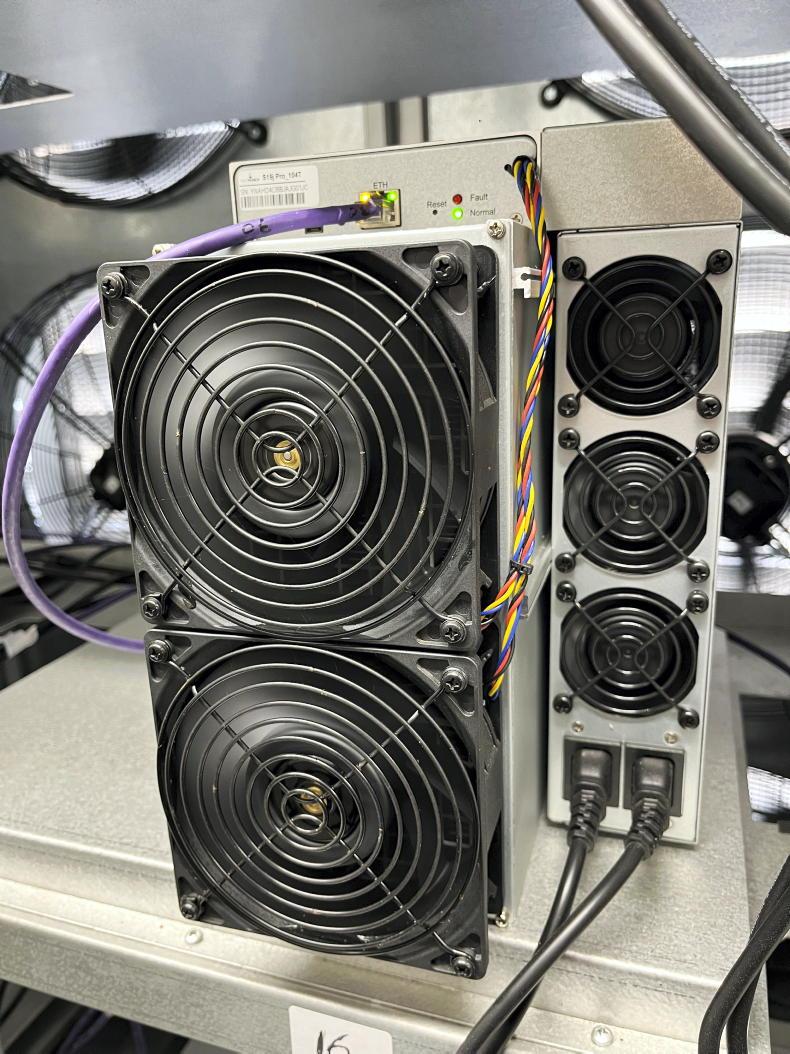
An ASIC.
As the unit is run on electricity produced from the AD plant, the ASICs run 24/7. However, if electricity generation is more intermittent, such as in a wind or solar farm, the system can turn on and off as needed. Scilling monitors all processes in the unit from its offices in Cork.
Payback
Tom’s unit is the first commercialised unit of this scale in Ireland and it sits on top of his AD plant. Mark believes that there is a big future for bitcoin mining from stranded electricity and there are multiple options for farmers to get involved, he explained. Tom opted to partner with Mark to install the system.
Once a bitcoin is mined, it is transferred to Tom’s digital wallet where he can save, trade or sell them. On average, each machine will generate around €6/day in bitcoins and despite the fall in cryptocurrency value, Tom will have this system paid for in under three years. All going well, Tom plans to scale up the unit while increasing the output of his AD plant. Even if he could export his stranded electricity to the grid, he said it would still be more profitable for him to mine during periods of low electricity export prices, such as during off-peak times at night.
Future of bitcoin
Cryptocurrencies have taken a hammering recently with the collapse of exchange firm FTX, a broader economic downturn and concerns about the future of digital currency. At the time of writing, bitcoin was trading at around €16,000 per coin after collapsing nearly 75% in value over recent months. When questioned on this, Tom said he makes a clear distinction between bitcoin and everything else. He believes bitcoin, the original and most widely traded cryptocurrency, is here for the long run irrespective of the rise and fall of other types of cryptocurrencies.
View on AD
Tom was an early adoptor of AD and developed two 500kW projects in NI, supported by the NIRO. He thinks NI is a good example of how AD can be developed and scaled up quickly across the Republic of Ireland (ROI).
Overall, he thinks AD has had a significantly positive impact on his farm and on rural communities across NI. However, a secure government-backed support scheme was essential to allow him to invest in and develop his plant in NI. ROI will need the same in order to create the right conditions for investment he said.
Tom explains that the next step for many AD plants in NI will be to consider producing biomethane. This will involve the scaling up of farm-based AD plants but this should not be a problem. These operators already have experience in running AD plants but the same can not be said for ROI.
There are many factors to consider when deciding on the scale at which to develop a renewable energy project. Cost, access to resources, planning permission requirements and risk are all valid factors to consider.
However, in the case of renewable electricity generators, one of the most important factors to consider is the volume of electricity you can physically export through the grid. This volume is often limited for a range of reasons which, in turn, restrict the potential size of that project.
This is known as “stranded” electricity and can occur on any renewable electricity project including solar PV systems, wind farms and anaerobic digestion (AD) plants.

The bitcoin mining unit sits on top of Tom Campbell's AD plan in Lurgan, Armagh
However, one such AD plant in Lurgan, Co Armagh, has partnered with Cork company Scilling Digital Mining to use the stranded electricity from the plant to mine bitcoin. The Irish Farmers Journal recently visited the site to learn more.
AD plant
Tom Campbell runs a 500kW Hochreiter AD plant which produces electricity on his farm outside of Lurgan. The plant uses around 8,000t of feedstock per year, which consists of a combination of grass silage, farmyard manure, whole crop forage and dairy waste to produce biogas. The biogas is burned in a power plant to produce electricity which is then exported through the national grid.
Like most AD plants in Northern Ireland (NI), the project is supported by the NI Renewables Obligation (NIRO), a 20-year government support scheme.
Under the scheme, AD plants with an output of 500kW or below are awarded four Renewable Obligation Certificates (ROCs) per kWh of electricity produced and these can be traded at a premium. However, AD plants above 500kW are only awarded three ROCs so many farm-scale AD plants found it more economically viable to stay just below 500kW in output.
However, like Tom’s operation, many AD plants have the capacity to produce more electricity but, due to the constraints of the scheme, they would not be able to export this to the grid.
Tom thought he could increase output from his AD plant by another 200kW without any significant infrastructural change so he decided to explore alternative ways to use this stranded electricity. He had a keen interest in the emerging digital currency industry where he found Mark Morton of Scilling Digital Mining. Together, they developed the world’s first biogas-powered bitcoin mining system.
Scilling Digital Mining
Mark and his business partner Stewart Hosford founded Scilling Digital Mining in 2021. From a farming background in Cork, Mark studied financial maths and actuarial science in college and always had a keen interest in bitcoin. Having looked at several options to get involved with bitcoin and accumulate as much of it as possible, they decided that developing a system that generated new bitcoin was the best way forward for them.

The unit are 35 Application Specific Integrated Circuits (ASICs) which are the specialised machines designed to generate guesses as quickly as possible.
Bitcoin first appeared to many of us around 2015 but it was actually developed in 2009. It’s a digital global payment system or cryptocurrency which can be traded or used as digital tender.
New bitcoins are generated through a system called mining. The process of bitcoin mining involves machines trying to guess a code to verify blocks of digital transactions on the bitcoin blockchain ledger.
The bitcoin blockchain ledger is essentially just like a ledger used in traditional accounting which has time-stamped all the transactions that have occurred since its inception in 2009. Each block contains transactions that have occurred in a 10-minute period.

Tom runs a Hochreiter AD plant which has a concrete roof where the unit sits on top of.
Basically, every block that appears on the bitcoin blockchain has an extremely long combination code that must be guessed correctly before that block can be added to the blockchain. If the machine guesses correctly, then the miner is automatically rewarded in bitcoin by the network. On average a new block is added every 10 minutes. In simple terms the mining process is akin to playing a lottery that occurs every 10 minutes.
Mining bitcoin is energy intensive and Mark explained that it would not be economically feasible to import electricity to run the system and it would also put pressure on the local grid.
That is why they target stranded electricity from renewable generators to power the bitcoin mining system.
Modular system
Mark developed a unique modular unit which contains all of the components needed for using stranded electricity to mine bitcoin. The unit was designed in conjunction with two other Irish companies, Mark Eire and Weldon Electrical. It consists of a corrosion-resistant aluzinc container with intake and extraction fans to moderate internal temperature.
Inside the unit there are 35 application-specific integrated circuits (ASICs), which are the specialised machines designed to generate guesses as quickly as possible. Each ASIC generates 104 trillion guesses per second. The unit can accommodate a further 33 ASICs, which Tom can install at a later date. Each ASIC needs around 3kWh of electricity to run and produces a lot of heat. The units need to be kept at around 15°C, which is done by sucking in cooler air from outside. The hot air produced can be used to heat the digester or for other purposes.

An ASIC.
As the unit is run on electricity produced from the AD plant, the ASICs run 24/7. However, if electricity generation is more intermittent, such as in a wind or solar farm, the system can turn on and off as needed. Scilling monitors all processes in the unit from its offices in Cork.
Payback
Tom’s unit is the first commercialised unit of this scale in Ireland and it sits on top of his AD plant. Mark believes that there is a big future for bitcoin mining from stranded electricity and there are multiple options for farmers to get involved, he explained. Tom opted to partner with Mark to install the system.
Once a bitcoin is mined, it is transferred to Tom’s digital wallet where he can save, trade or sell them. On average, each machine will generate around €6/day in bitcoins and despite the fall in cryptocurrency value, Tom will have this system paid for in under three years. All going well, Tom plans to scale up the unit while increasing the output of his AD plant. Even if he could export his stranded electricity to the grid, he said it would still be more profitable for him to mine during periods of low electricity export prices, such as during off-peak times at night.
Future of bitcoin
Cryptocurrencies have taken a hammering recently with the collapse of exchange firm FTX, a broader economic downturn and concerns about the future of digital currency. At the time of writing, bitcoin was trading at around €16,000 per coin after collapsing nearly 75% in value over recent months. When questioned on this, Tom said he makes a clear distinction between bitcoin and everything else. He believes bitcoin, the original and most widely traded cryptocurrency, is here for the long run irrespective of the rise and fall of other types of cryptocurrencies.
View on AD
Tom was an early adoptor of AD and developed two 500kW projects in NI, supported by the NIRO. He thinks NI is a good example of how AD can be developed and scaled up quickly across the Republic of Ireland (ROI).
Overall, he thinks AD has had a significantly positive impact on his farm and on rural communities across NI. However, a secure government-backed support scheme was essential to allow him to invest in and develop his plant in NI. ROI will need the same in order to create the right conditions for investment he said.
Tom explains that the next step for many AD plants in NI will be to consider producing biomethane. This will involve the scaling up of farm-based AD plants but this should not be a problem. These operators already have experience in running AD plants but the same can not be said for ROI.









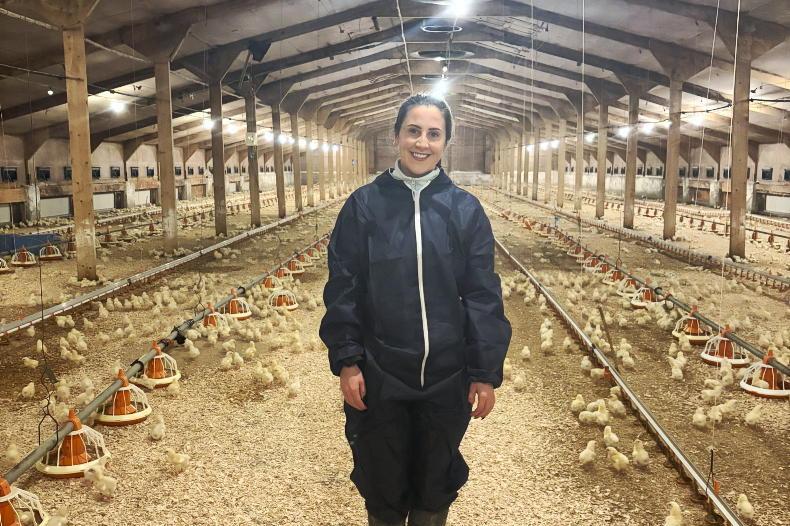

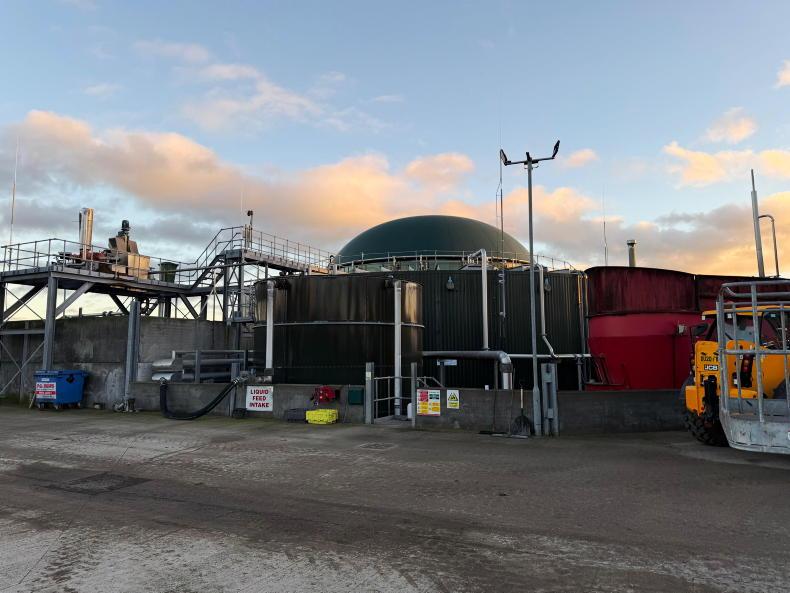

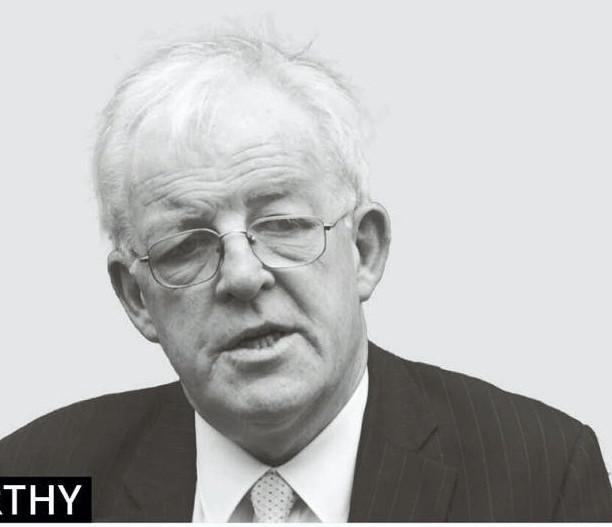
SHARING OPTIONS